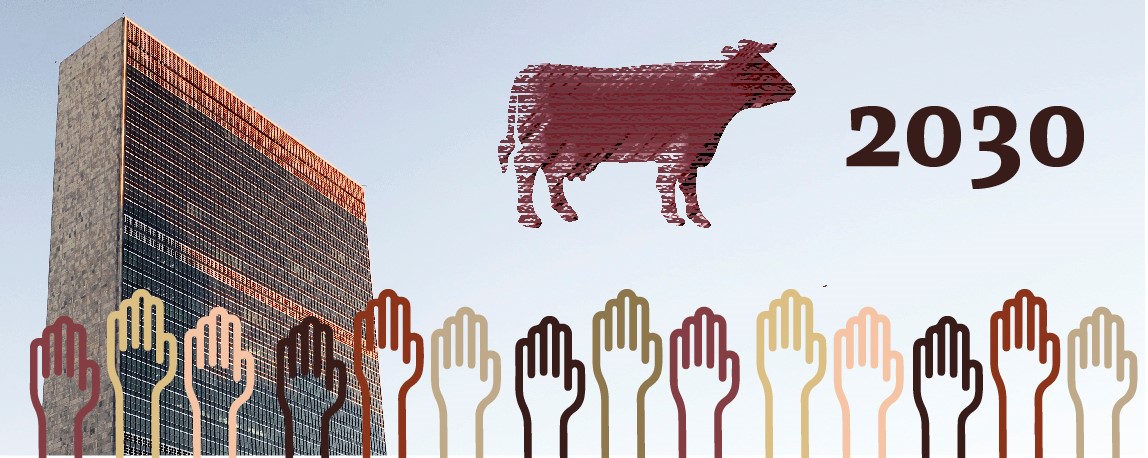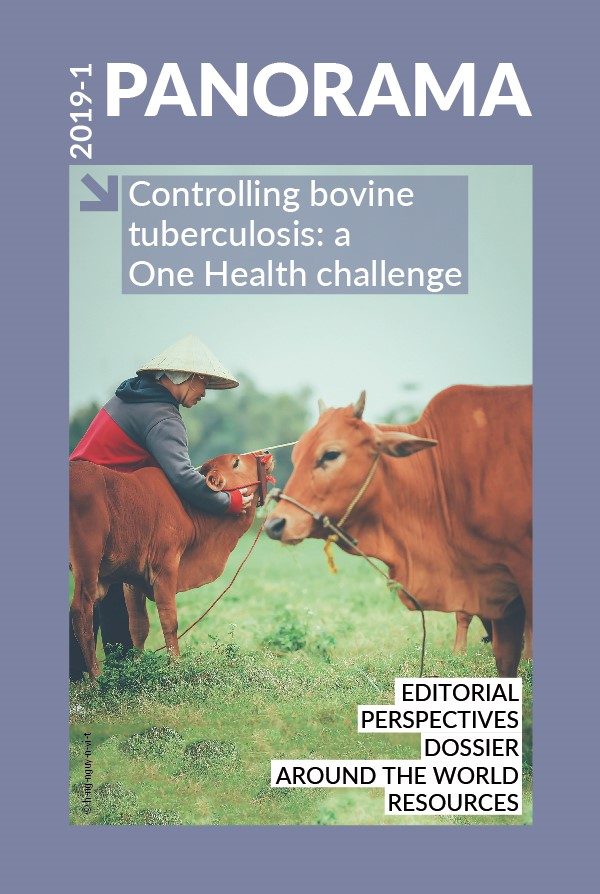Around the world Posted on 2019-05-21 17:02:10
Thematic events
The United Nations High-Level Meeting on tuberculosis
Its importance for zoonotic and bovine tuberculosis
Keywords
Authors
Paula I. Fujiwara(1)* & Francisco Olea-Popelka(2)
(1) Scientific Director, International Union Against Tuberculosis and Lung Disease, Paris, France.
(2) Associate Professor, Department of Clinical Studies, College of Veterinary Medicine & Biomedical Sciences, Colorado State University, Fort Collins, Colorado, United States of America.
* Corresponding author: pfujiwara@theunion.org
The designations and denominations employed and the presentation of the material in this article do not imply the expression of any opinion whatsoever on the part of the OIE concerning the legal status of any country, territory, city or area or of its authorities, or concerning the delimitation of its frontiers and boundaries.
The views expressed in this article are solely the responsibility of the author(s). The mention of specific companies or products of manufacturers, whether or not these have been patented, does not imply that these have been endorsed or recommended by the OIE in preference to others of a similar nature that are not mentioned.
On 26 September 2018, the United Nations (UN) held a High-Level Meeting (HLM) on tuberculosis (TB), the infectious disease that currently kills the most people worldwide [1]. This HLM was the culmination of nearly two years’ work since it was originally proposed in December 2016.
Relevant input for the political declaration was coordinated by the ‘Stop TB’ Partnership and the World Health Organization (WHO). Staff of the International Union Against Tuberculosis and Lung Disease (the Union) were in charge of developing the TB community’s five key priority actions to be included in the political declaration developed by the UN country missions. These were to [2]:
- reach all people by closing the gaps in TB diagnosis, treatment and prevention
- transform the tuberculosis response to be equitable, rights-based, and people-centred
- accelerate the development of essential new tools to end TB
- invest the funds necessary to end TB
- commit to decisive and accountable global leadership, including regular UN reporting and review.
Bovine and zoonotic tuberculosis were included in the UN political declaration
Bovine and zoonotic tuberculosis (caused by Mycobacterium bovis) were included in the declaration, based on two key advocacy efforts.
- The fourth edition of The Global Plan to End TB: the Paradigm Shift 2016–2020 identified key populations at risk, which included people who live and work with livestock [3].
- The Tripartite of the World Organisation for Animal Health (OIE), the World Health Organization (WHO) and the Food and Agriculture Organization of the United Nations (FAO) collaborated with the Union to produce a multisectoral Roadmap for Zoonotic Tuberculosis in 2017, based on the WHO Strategic and Technical Advisory Group’s previous recognition of zoonotic tuberculosis as a priority [4].
The availability of these two documents convinced the UN missions to include both bovine and zoonotic tuberculosis in the political declaration.
The two key points on bovine and zoonotic tuberculosis in the 16-page political declaration [5] are found in paragraphs 5 and 17:
Paragraph 5. ‘Recognize other recent high-level commitments and calls for action against tuberculosis, including against its multidrug-resistant and zoonotic forms, made by global, regional and sub-regional bodies and meetings, including the Delhi End TB Summit held from 12 to 17 March 2018.’
Paragraph 17. ‘Recognize the enormous, often catastrophic, economic and social impacts and burden of tuberculosis for people affected by the disease, their households, and affected communities, and that the risk and impact of tuberculosis can vary depending on demographic, social, economic and environmental circumstances, and, in order to make the elimination of tuberculosis possible, prioritizing, as appropriate, notably through the involvement of communities and civil society and in a non-discriminatory manner, high-risk groups as well as other people who are vulnerable or in vulnerable situations, such as women and children, indigenous peoples, health care workers, migrants, refugees, internally displaced people, people living in situations of complex emergencies, prisoners, people living with HIV and AIDS, people who use drugs particularly those who inject drugs, miners and others exposed to silica, urban and rural poor, underserved populations, undernourished people, individuals who face food insecurity, ethnic minorities, people and communities at risk of exposure to bovine tuberculosis, people living with diabetes, people with mental and physical disabilities, people with alcohol use disorders, and people who use tobacco, recognizing the higher prevalence of tuberculosis among men.’
This recognition by the United Nations of the importance of tuberculosis as a major cause of morbidity and mortality will serve to energise the entire tuberculosis community, including those addressing its zoonotic and bovine forms.
In two articles published in 2018, one in Frontiers in Public Health [6] and another in The Lancet: Infectious Diseases [7], the practical actions that need to be taken between now and 2025 as part of the Roadmap for Zoonotic Tuberculosis, to ‘improve the scientific evidence base, reduce transmission at the animal–human interface and strengthen intersectoral and collaborative approaches’ were highlighted.
On 4 October 2018, the G20 Health Ministers’ Meeting at Mar del Plata, Argentina, issued its own declaration, recognising the contribution of the Tripartite to ‘address the threats of zoonotic diseases and improve animal health sector capacities and implement One Health, multi-sectoral approaches to accelerate health security’ [8].
Finally, the Seventh International Conference on Mycobacterium bovis (M. bovis 2020) will be held in Galway, Ireland, where plans are being made to further highlight and discuss the remaining zoonotic tuberculosis challenges and opportunities to be addressed if we are to accomplish the milestones outlined in the Roadmap for Zoonotic Tuberculosis.
Momentum is building. Now is the time to take the words of the United Nations Political Declaration as the starting point for human and veterinary communities to join together to end tuberculosis by 2030, as stipulated in Sustainable Development Goal 3 [9].
http://dx.doi.org/10.20506/bull.2019.1.2930
References
- World Health Organization (WHO) (2018). – Global tuberculosis report.
- United Nations Office for Project Services (UNOPS) Stop TB Partnership (2018). – United to end tuberculosis. An urgent global response to a global epidemic. Key asks from TB stakeholders and communities.
- United Nations Office for Project Services (UNOPS) Stop TB Partnership (2018). – Global plan to end TB: The paradigm shift 2016–2020.
- World Health Organization (WHO), World Organisation for Animal Health (OIE) & Food and Agriculture Organization of the United Nations (FAO) (2017). – Roadmap for Zoonotic Tuberculosis.
- United Nations (UN) (2018). – Political declaration of the high-level meeting of the General Assembly on the fight against tuberculosis. UN General Assembly, New York, 26 September 2018.
- Olea-Popelka F. & Fujiwara P.I. (2018). – Building a multi-institutional and interdisciplinary team to develop a zoonotic tuberculosis roadmap. Front. Public Health, 6 (Art 167). https://doi.org/10.3389/fpubh.2018.00167.
- Dean A.S., Forcella S., Olea-Popelka F., El Idrissi A., Glaziou P., Benyahia A., Mumford E., Erlacher-Vindel E., Gifford G., Lubroth J., Raviglione M. & Fujiwara P. (2018). – A roadmap for zoonotic tuberculosis: a One Health approach to ending tuberculosis. Lancet Infect. Dis., 18 (2), 137–138. https://doi.org/10.1016/S1473-3099(18)30013-6.
- University of Toronto (2019). – Declaration. G20 Meeting of Health Ministers, 4 October 2018, Mar del Plata, Argentina.
- United Nations (UN) Sustainable Development Goals Knowledge Platform. – Sustainable Development Goal 3.












